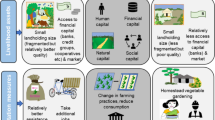
Climate-resilient crops and crop varieties have been recommended as a way for farmers to cope with or adapt to climate change, but despite the apparent benefits, rates of adoption by smallholder farmers are highly variable. Here we present a scoping review, using PRISMA-P (Preferred Reporting Items for Systematic review and Meta-Analysis Protocols), examining the conditions that have led to the adoption of climate-resilient crops over the past 30 years in lower- and middle-income countries. The descriptive analysis performed on 202 papers shows that small-scale producers adopted climate-resilient crops and varieties to cope with abiotic stresses such as drought, heat, flooding and salinity. The most prevalent trait in our dataset was drought tolerance, followed by water-use efficiency. Our analysis found that the most important determinants of adoption of climate-resilient crops were the availability and effectiveness of extension services and outreach, followed by education levels of heads of households, farmers’ access to inputs—especially seeds and fertilizers—and socio-economic status of farming families. About 53% of studies reported that social differences such as sex, age, marital status and ethnicity affected the adoption of varieties or crops as climate change-adaptation strategies. On the basis of the collected evidence, this study presents a series of pathways and interventions that could contribute to higher adoption rates of climate-resilient crops and reduce dis-adoption.

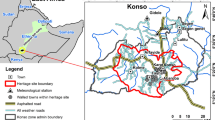
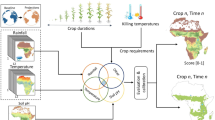
Agriculture and food production are highly vulnerable to climate change. Extreme weather events such as droughts, heat waves and flooding have far-reaching implications for food security and poverty reduction, especially in rural communities with high populations of small-scale producers who are highly dependent on rain-fed agriculture for their livelihoods and food. Climate change is expected to reduce yields of staple crops by up to 30% due to lower productivity and crop failure 1 . Moreover, the projected global population growth and changes in diets toward higher demand for meat and dairy products in developing economies will stretch natural resources even further, increasing demands on food production and food insecurity 2 . To cope with climate change, farmers need to modify production and farm management practices, such as adjusting planting time, supplementing irrigation (when possible), intercropping, adopting conservation agriculture, accessing short- and long-term crop and seed storage infrastructure, and changing crops or planting more climate-resilient crop varieties.
This scoping review examines the conditions that have led to the adoption of climate-resilient crops over the past 30 yr in lower- and middle-income countries. For all countries, but especially those that rely on domestic agriculture production for food security, one of the most critical and proactive measures that can be taken to cope with food insecurity caused by unpredictable weather patterns is for farmers to adopt climate-resilient crops. Climate-resilient crops and crop varieties have enhanced tolerance to biotic and abiotic stresses 3 (Box 1). They are intended to maintain or increase crop yields under stress conditions and thereby provide a means of adapting to diminishing crop yields in the face of droughts, higher average temperatures and other climatic conditions 4 . Adoption of climate-resilient crops, such as early-maturing cereal crop varieties, heat-tolerant varieties, drought-tolerant legumes or tuber crops, crops or varieties with enhanced salinity tolerance, or rice with submergence tolerance, can help farmers to better cope with climate shocks. Climate-resilient crops and crop varieties increase farmers’ resilience to climate change, but despite their benefits, adoption rates by small-scale producers are not as high as expected in some cropping systems 4,5,6 . In this study, we focus on scoping (reviewing and synthesizing) the published evidence on the adoption of climate-resilient crops and crop varieties from climate-vulnerable countries and countries that have experienced climate-related impacts as determined by 45 indicators established by the Notre Dame Global Adaptation Initiative.
Overall, we find that the most important determinants of adoption of climate-resilient crops are the availability and effectiveness of extension services and outreach, education level of heads of households, including some awareness of climate change and adaptation measures, and farmers’ access to inputs, especially seeds and fertilizers. On the basis of the collected evidence, this scoping review presents a series of pathways and interventions that can contribute to higher adoption rates of climate-resilient crops and reduce dis-adoption (Box 2).
The inclusion criteria for this study were:
A scoping review aims to explore the key concepts underpinning a research area and the main sources and types of evidence available 7 . Established scoping review methods provide an evidence-based framework for systematically searching and thematically characterizing the extent, range and nature of existing evidence. A PRISMA-P protocol for this scoping review 8 was registered on 4 June 2019 on the Open Science Framework. We performed double-blind title and abstract screening of 5,649 citations, selecting 568 papers for full-text screening using a priori inclusion and exclusion criteria; 202 papers met the inclusion criteria for data extraction. The inclusion and exclusion criteria are available in the protocol (Methods and Supplementary Information), and the data-extraction procedure and the PRISMA flow diagram of included and excluded studies are presented in the Supplementary Information.
Of the 202 papers included, 89% were published in peer-reviewed journals and 11% were published in the grey literature. Eighty-seven studies used mixed methods, 82 used quantitative methods and 33 studies used qualitative methods.
Of the 29 evaluated potential social and economic factors related to adoption, interventions related to the availability, effectiveness and access to agricultural extension services were the most prominent determinants of the adoption of climate-resilient crops in low- and middle-income countries. Nearly 50% of the studies identified extension services and awareness outreach as important factors for the effective adoption of climate-resilient crops in low- and middle-income countries (Fig. 1). The individual figures per characteristic are presented in detailed summary graphs in Extended Data Figs. 1–5. The determinants are plotted in bar charts to provide additional context and visualization. The unit of analysis is per study, and a single study can report on multiple determinants.

The principal factors determining adoption of climate-resilient crops or crop varieties were largely consistent across the three regions with robust numbers of publications: sub-Saharan Africa, South Asia and East Asia. The most important determinants across these regions were, in order of importance: (1) access to extension services or information about options, (2) education level of head of household, (3) access to needed farm inputs, (4) experience and skills of farmer, (5) social status, and (6) access to climate information (Fig. 2). Access to extension services and information about options, and education level of head of household were among the top five determinants for adoption for all three regions. Access to farm inputs was the first and second most important determinants for adoption in South Asia and sub-Saharan Africa, respectively, but was only sixth most important for East Asia. Experience and skills of farmers were first and third most important determinants for adoption in East Asia and sub-Saharan Africa, respectively, and sixth most important in South Asia. Social status was highly important in South Asia and sub-Saharan Africa, but only moderately important for determining adoption of technologies in East Asia. Although there were few papers and thus limited information for Latin America and Middle East and North Africa regions, the education level of the head of household was cited as the most important determinant for adoption in both regions.
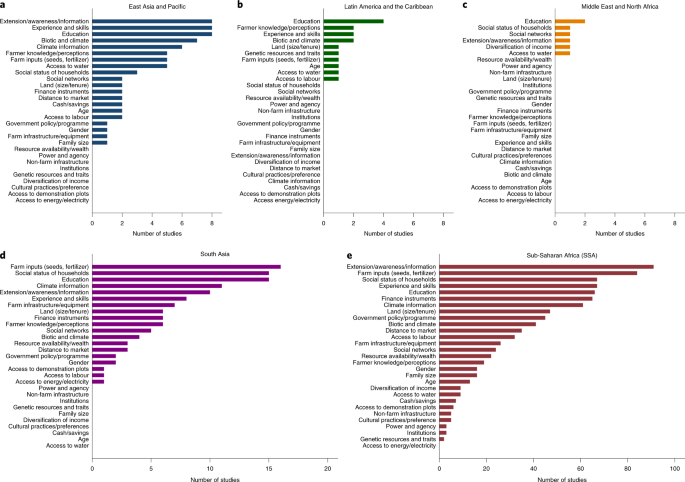
The climate-resilient crops are included in this scoping review on the basis of data found in the included papers (Fig. 3). We classified them as cereals (maize, rice, grain (general), wheat, millet, sorghum barley and teff), legumes (soybean, chickpeas, cowpea, common beans, mung beans and groundnut), vegetables and fruits (tomato, eggplant, pepper, cocoa, mango, clover, garlic, mustard, pea, onion, saffron, green grams and cola nut) and roots, tubers and bananas (banana, plantain, yam, sweet potato, cassava and potato). Thirty-three per cent of the studies did not report on a specific crop or variety in their research; of the studies that did report on a specific crop or variety, 67% reported on cereals only. Despite their importance for food security and nutrition, less than 1% of the studies reported on legumes only and 25% reported on a combination of cereals and legumes, roots, tubers, bananas, vegetables and fruits. We also assessed the 202 papers to determine the purpose of the crops as primarily for human consumption (44%), for human consumption and animal feed (26%) or not clearly stated (30%).
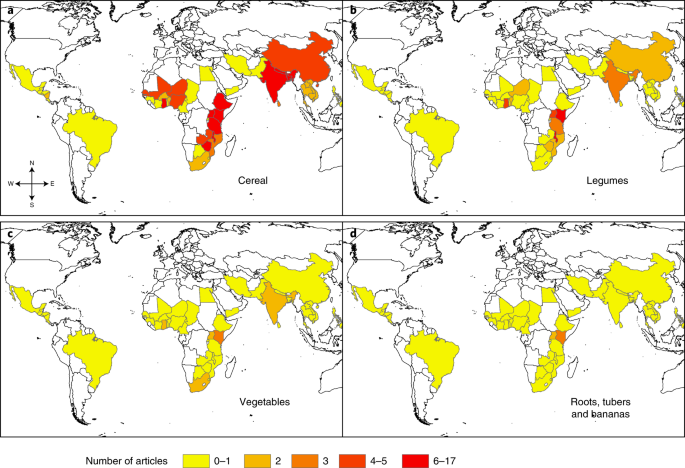
Climate-resilient crops and crop varieties were adopted to cope with abiotic stresses such as drought, heat, flooding, salinity and shorter growing season (early-maturing crops), as well as pests associated with changes in weather or climate patterns (disease and pest resistance) (Fig. 4). Climate-resilient crops and crop varieties were also adopted to address general challenges associated with climate change and crop system sustainability, such as to improve moisture retention in soil, improve soil quality, and reduce erosion (planting of cover crops and legumes and to reduce vulnerability to food insecurity). The most studied trait in the dataset was drought tolerance, followed by water-use efficiency and earlier maturity. Adoption of early-maturing crops enables farmers to cope with climate change-induced weather variability by allowing them to adjust planting dates when rains are delayed and reducing the chances of yield losses caused by drought or heat waves late in the growing season. Changing of planting dates was identified in 32% of the papers as a strategy to cope with climate change.
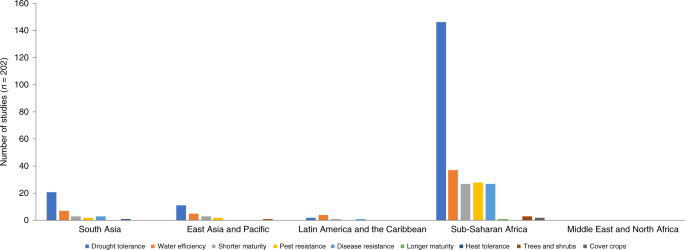
In general, the evidence suggests that farmers do not adopt a new crop or crop variety without changing other practices. A total of 136 papers (67%) describe that farmers adopt climate-resilient crops in conjunction with other climate-resilient technologies such as climate-smart agriculture (CSA) schemes and conservation agriculture (CA). Other climate-resilient technologies included: planting of trees and shrubs, reduced or increased investment in livestock and modified planting dates and irrigation (Table 1).
Table 1 Adoption of climate-resilient crops as part of broader climate-resilience strategiesSeventy-three papers mentioned the topic of seed. The major themes associated with seed that emerged with direct evidence drawn from the papers are summarized in Table 2. Access to and availability of seed were the most prevalent themes, with 60% of papers mentioning these as issues in the adoption of climate-resilient strategies. Social networks such as farmers’ organizations or co-operatives, as well as access to information, were also reported as facilitators of adoption. These themes refer to different social groups and ways in which farmers can exchange seed or get information about seed.
Table 2 Seed factors associated with adoption of climate-resilient crops and crop varietiesAbout 53% of studies reported that social differences (such as sex, education and age of household head) influence adoption of varieties or crops as mitigation strategies against the effects of climate change, whereas 30% of studies did not report any effect of social difference. Fifteen per cent of studies did not include data on social differences. Of the studies that identified social differences as influencing adoption of climate-resilient crops and crop varieties, education (22%), sex (28 %), age (24%) and family size (14%) emerged as the most important factors. Income (6%), access to information (5%), marital status (2%) and experience (2%) were also mentioned, but much less frequently. We examined the papers for sex disaggregation of data, in which sex of household heads was considered. Forty-five per cent of studies reported on the sex of respondents, with 39% reporting on both male and female household heads, 5% including men only, and only 1% of studies including only female respondents. Most of the studies explored social differences only superficially, by including variables in surveys, but few substantiated these findings with follow-up qualitative research to understand the social dynamics driving the observed adoption decisions.
The studies largely concur that socio-economic status of farmers plays a large part in their adoption of climate-resilient technologies. Thirty-one per cent of the studies highlighted the socio-economic status of farmers. Various studies indicated that a nuanced understanding of the socio-economic status of farmers is vital for the targeting of climate-resilient crop technology interventions and their adoption and sustainability in practice. Thirteen studies reported a positive effect of farmer income on adoption. Farmers with access to finance, such as risk transfers (for example, insurance or remittances) and credit (for example, bank loans or community loans), were more likely to adopt climate-resilient crop technologies. Farmers who reported constrained credit were less likely to grow modern crops and more likely to cultivate local varieties 9 . This is partly because the lack of cash or credit may prevent farmers from using purchased inputs 10 .
Dis-adoption of climate-resilient crops and crop varieties was discussed in 12 of the 202 papers included in our evidence synthesis. The major reasons for dis-adoption included technology not meeting expectations due to poor performance or quality of the technology or variety (8 papers), government policies (3 papers), technical constraints (2 papers), labour shortages (1 paper) or financial constraints (1 paper). Eight of the twelve studies indicated that dis-adoption was specifically due to the performance of a crop variety, and four of these eight studies indicated that the varieties’ performance under stress conditions did not meet farmers’ expectations 10,11,12,13 .
The primary goal of this scoping review was to identify factors in adoption of climate-resilient crops in climate-vulnerable countries. Insights into these factors may inform the design of interventions aimed at equipping farmers to adopt climate-resilient technologies before experiencing devastating impacts of climate change and encourage adoption best practices 14,15 .
We show that there is a predominance of cereals in reported studies on adoption of climate-resilient crops (67%). Only 1% of the studies report on legumes only; otherwise, they are considered only in combination with other crops. This may reflect the dominance of cereals in staple foods across the world and biases towards the study of such crops and in the development of improved climate-resilient crop varieties. However, this is a concerning trend given that some legumes, roots and tuber crops (for example, cassava, bambara groundnuts and beans) that are largely neglected in the studies have known climate resilience, are sources of high-quality nutrition and provide more well-established environmental benefits than cereals, such as soil enrichment.
About 50% of the studies included in this scoping review identified agricultural extension and awareness outreach as the most relevant factor for adoption of climate-resilient technologies in low- and middle-income countries. Agricultural extension links farmers with the latest research and engages in a translational practice to make complex information more accessible to farmers. It has been shown that farmers who have access to early-warning systems such as weather forecast systems can better cope and adapt to a changing climate 16 . Farmers plan better for farming activities, including choice of crop varieties to plant, after having had access to weather forecast information (for example, from a community-managed weather station). Emerging digital technologies provide an opportunity to use information and communications technology-enhanced extension and climate services that can provide timely information that farmers can use for decision making and to adapt their farming practices. These could also improve efficiencies of extension services while also reducing their cost. Poor funding for extension services in the developing world have limited farmers’ access to training and expert guidance on emerging technologies 17 . Partnerships with other emerging players in information exchange, such as telecommunications companies and non-governmental organizations, will be key.
Farmers generally tend to be risk averse, which leads to limited investment and adoption of improved agricultural production technology 18 . Experienced farmers use precautionary strategies to protect against the possibility of catastrophic loss in the event of a climatic shock and thus optimize management for average or likely conditions, but not for unfavourable conditions. These ex ante, precautionary strategies include selection of crops and cultivars and improved production technology 18 .
In general, there is widespread agreement that aside from the useful experience that farmers gain from the time they have spent in farming, their experience with climatic shocks is key to their adoption of climate-resilient technologies. Many studies showed that farming experience is influential in adoption and utilization, and previous experiences with environmental shocks such as drought can influence adoption of climate-resilient crops and crop varieties. The more experience farmers have with climatic shocks, the more likely they are to be receptive to the adoption of related climate-resilient technologies. For example, experience with drought shock in the agro-ecological zone of Brong Ahafo, Ghana, increased the probability of adoption of drought-tolerant varieties by 15%, and farmers reported that drought shock was the primary reason for adoption of drought-tolerant varieties 19 .
It has been widely acknowledged that education levels of farmers have a positive correlation with technology adoption, and our synthesis demonstrates that this is also relevant for the adoption of climate-resilient crops 16,20,21,22 . Highly educated heads of households are more likely to readily accept and access information about new technologies in a shorter period of time than less educated heads of households; education was measured as educational attainment and reported in 49% of the studies. A study based in Zimbabwe showed a 52% decrease in production of traditional sorghum varieties in favour of new varieties better suited to drier conditions for every additional year of schooling, and a 5% increase in growing new early-maturing varieties 23 .
Changing crop varieties is one of the most frequently cited climate-resiliency strategies for both men and women farmers, but women are more likely to adopt such strategies when they are aware of climate-adaptation options 24 . Other intersectional variables such as marital status, education and age, in combination with gender, influenced whether improved seed was grown by households 25 . A major shortcoming of the reviewed literature is that most studies included women only when they were household heads. Definitions of household headship are variable, and when women are only included as household heads, their views do not necessarily represent the views of women who live in male-headed households 26 . A large majority of women live in male-headed households, and their views are rendered invisible through this practice 27 . For example, young, poor women who were household heads were the least likely to adopt drought-tolerant maize in Uganda, whereas spouses of male household heads influenced adoption decisions on their husbands’ fields 9 . Only a few studies paid attention to intra-household dynamics, gender roles and relations, and how these shape adaptation decisions 9,28 . This limited attention on intra-household gender dynamics and decision making around climate-resilient seed adoption skews the conclusions and recommendations, as the literature does not equally represent the challenges and views of women.
Seed policies in many countries focus on strengthening formal, national seed systems that rely on variety-release mechanisms, seed certification policies and seed companies for distribution. These types of seed systems remain difficult to access for many farmers, and evidence from the papers in this scoping review suggests that strengthening local seed systems is essential. Local seed systems rely on social networks to ensure multiple options to access seed of a range of climate-resilient crops and varieties, including local landraces and improved seed. Thus, context specificity is important for seed systems, as it is for almost all factors influencing adoption of climate-resilient crops and varieties.
The determinants of adoption that we identified are, in many cases, context-specific and therefore implementation of specific interventions is most successful when they are tailored to their environment and the cropping system. Seemingly contradictory or opposing (positive and negative) effects of each determinant of adoption were commonly reported among—and sometimes within—studies. Sex, age, education, years of farming experience and indicators of socio-economic status or wealth (assets) all affected decisions to adopt climate-resilient technologies in context-specific and sometimes opposite ways, depending on interacting environmental, policy and household factors. For example, equal and sizable numbers of studies (13 each) identify positive and negative effects of age on adoption. Whereas some studies identified older farmers to be more reluctant to adopt new technologies, other studies found that the earned experience, broad social networks and accumulation of wealth associated with older farmers may explain a positive effect on adoption. Extension and access to information about climate-resilient technologies and weather might be exceptions to this trend, as these determinants seem to transcend context-specific implementation. The resulting conclusion is that there is no ‘one size fits all’ recommendation to ensure adoption of climate-resilient crops and crop varieties, and interventions are unlikely to uniformly benefit all climate-vulnerable farmers (Table 3). This is consistent with the large number of papers in this study that reported farmers adopting climate-resilient crops as part of broader climate-resilient strategies.
Table 3 What does the evidence say? Specific undertakings to improve adoption of climate-resilient crops and crop varieties
Climate resiliency at farm level is essential to achieve food security and improve livelihoods of rural communities, especially in countries and communities that depend on local agricultural production to ensure household income and achieve daily adequate caloric intake and balanced nutrition. Understanding the factors contributing to adoption and dis-adoption of climate-resilient crops provides opportunities to increase adoption and reduce the impact of climate change on rural communities in developing countries. The most important determinants of adoption of climate-resilient crops based on our analysis are the availability and effectiveness of extension services and outreach, followed by education levels of heads of households, farmers’ access to inputs, especially seeds and fertilizers, and socio-economic status of farming families. Building resilience to climate change requires a cropping-systems, and more often a farming-systems approach. The results from this scoping review show that the adoption of climate-resilient crops and varieties, in most cases, happens as part of whole-farm and climate-smart agriculture strategies to cope with changing climate. Farmers adopting multiple complementary strategies under climate-smart agriculture help to build highly resilient and sustainable agriculture systems that can respond to shocks associated with climate change and other agricultural challenges 29,30,31 . Single component intervention programmes or projects are therefore less likely to realize widespread adoption and improvement of resource-poor farmers’ resilience to climate change compared with more holistic, multifaceted approaches that take into consideration the physical, human and socio-economic circumstances of the targeted farmer or farming community. Specific policy recommendations are presented in Box 3.
Unlike a typical narrative review, a scoping review strives to capture all the literature on a given topic and reduce authorial bias. Scoping reviews offer a unique opportunity to explore the evidence in agricultural fields to address questions relating to what is known about a topic, what can be synthesized from existing studies to develop policy or practice recommendations, and what aspects of a topic have yet to be addressed by researchers.
This scoping review was prepared following guidelines from the PRISMA extension for scoping reviews (PRISMA-ScR) 32 . This framework comprises five steps: identifying the research question; identifying relevant studies; study selection; extracting and charting the data; and collating, summarizing, and reporting the results 33 . The protocol for this scoping review was registered on the Open Science Framework before study selection 8 . The full protocol is available in the Supplementary Information.
The guiding question for this scoping review was, ‘what are determinants that lead small-scale producers in low-and middle-income countries to adopt climate-resilient crops and crop varieties?’.
An exhaustive search strategy was developed to identify all available research pertaining to facilitators that lead small-scale producers in low- and middle-income countries to adopt climate-resilient crop varieties. Search terms included variations of the key concepts in the research question: small-scale producers, germplasm and climate resilience. The search algorithms were formatted for compatibility with each database so that they may be reproduced in their entirety, and they can be accessed at https://osf.io/sfzcm/. Searches were performed in the following electronic databases by K.G.K.: CAB Abstracts and Global Health (accessed via Web of Science), Web of Science Core Collection (accessed via Web of Science) and Scopus (accessed via Elsevier). A comprehensive search of grey literature sources was also conducted. Search results were de-duplicated to remove redundant citations identified from multiple sources. To facilitate acceleration of the screening process, machine-derived metadata were added to individual citations, for example, identifying populations, geographies, interventions and outcomes of interest. This enabled accelerated identification of potential articles for exclusion at the title- or abstract-screening stage.
Studies were included for data extraction and analysis if (1) their focus included a population of small-scale food producers; (2) they were published between 1990 and the start of the search (1990 is when the IPCC first met and produced their first report on climate change); (3) they presented original research (qualitative and quantitative reports) and/or reviewed existing research, including grey literature; (4) they explicitly focused on or were clearly relevant to climate change resiliency or climate change adaptation; (5) they explicitly focused on crops, varieties, seed, planting materials or germplasm; (6) they mentioned factors for adoption; (7) they included target populations in countries classified as lower and middle-income by the World Bank. Studies that did not meet all of the aforementioned inclusion criteria were excluded.
Study selection was performed in two stages. In a first step, articles were uploaded to the systematic review software Covidence, and title and abstract screening was performed by all authors to exclude articles that did not meet all inclusion criteria. Each article was reviewed by two independent authors, and discrepancies were resolved by a third independent author. Full-text screening was then performed by M.A., K.C., S.M., N.Z., H.T., K.P., L.B. and K.I., and inclusion decisions were made by a single reviewer. Studies included in full-text screening were those that met all inclusion criteria or those whose eligibility could not be established during title and abstract screening. The PRIMSA flow diagram in the Supplementary Information presents the study selection process and indicates the number of articles excluded at each phase of screening.
A data-extraction template (available in the Supplementary Information) was developed to document the data and study type and context of each citation and all themes of interest. The data extraction first collected data on the paper quality, study location, population socio-economic data of the population and crop and cropping system characteristics. Second, the data-extraction template was used to collect information about the determinants of adoption and associated socio-economic factors influencing the adoption or dis-adoption of the climate-resilient crops. In total, 29 factors and determinants were selected. Additional rater observations and comments were included to increase analysis depth. Finally, raters also recorded policy and programmatic information and recommendations mentioned in the papers to support the adoption of climate-resilient crops. The data-extraction template was tested by the review team before use and data were extracted by the authors. The extracted data were qualitatively summarized on the basis of emerging themes and with the aim of providing recommendations to donors and policy makers. An assessment of study quality is not typically carried out as part of a scoping review 7,34 .
The data that support the findings of this study are available from the corresponding author upon request.